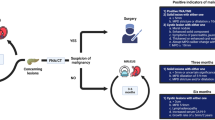Abstract
Background Serrated adenomas (SA) are histologically defined by the presence of both hyperplastic and adenomatous features. These uncommon polyps are thought to play an important role in the development of sporadic colorectal cancers (CRC) with microsatellite instability (MSI). There is paucity of data on the risk of progression of SA to CRC. This study was undertaken to define the relationship between SA and the future development of adenomatous polyps. Methods Colonoscopic biopsies that contained a pathologic diagnosis of SA were identified from a pathology database of a major urban academic medical center. Those patients with absence of concomitant malignancy, complete colonoscopy, good or adequate prep and presence of at least one follow-up procedures were identified. These were matched to controls by age, sex, indication for colonoscopy, polyp type and number and duration of follow-up. Outcomes of the follow-up procedures were compared. Results Between January 1997 and June 2005 17,226 colonoscopic biopsies and polypectomies were performed. Of these, 80 patients (0.5%) with SA were found, and of these SA, 80% were found in the left colon. The average age of patients undergoing colonoscopy was 58.5 years, and the average age of patients with SA was 68 years (P = 0.004). Of all patients with SA, 7 (9%) had concomitant CRC. The final groups contained 17 patients and 17 controls, respectively, and were well matched. The mean follow-up interval in the patient group was 29 months vs. 31 months in the control group (P = 0.82). On follow-up examination four patients (24%) and no controls had adenomatous polyps (P = 0.01). Conclusions While SA are uncommon, they are commonly associated with colorectal cancer. Serrated adenomas appear to be found more commonly in the left colon and in older patients. This study found a significant association between SA and the subsequent development of adenomatous polyps. Further studies are needed to define appropriate preventive strategies for these patients.

Similar content being viewed by others
References
Vogelstein B, Fearon ER, Kern SE et al (1989) Allelotype of colorectal carcinomas. Science 244:207–211
Vogelstein B, Fearon ER, Hamilton SR et al (1988) Genetic alterations during colorectal tumor development. N Engl J Med 319:525–532
Miyakura Y, Sugano K, Konishi F et al (2001) Extensive methylation of hMLH1 promoter region predominates in the proximal colorectal cancer with microsatellite instability. Gastroenterology 121:1300–1309
Huang CS, O’Brien M, Yang S et al (2004) Hyperplastic polyps, serrated adenomas, and the serrated polyp neoplasia pathway. Am J Gastroenterol 99:2242–2255
Urbanski SJ, Kossakowska AE, Marcon N et al (1984) Mixed hyperplastic and adenomatous polyps: an underdiagnosed entity; report of a case of adenocarcinoma arising within a mixed hyperplastic adenomatous polyp. Am J Surg Pathol 8:551–556
Longacre TA, Fenoglio-Preiser CM (1990) Mixed hyperplastic adenomatous polyps/serrated adenomas. A distinct form of colorectal neoplasia. Am J Surg Pathol 14:524–537
Iino H, Jass JR, Simms LA et al (1999) DNA microsatellite instability in hyperplastic polyps, serrated adenomas, and mixed polyps: a mild mutator pathway for colorectal cancer? J Clin Pathol 52:5–9
Park SJ, Rashid A, Lee JH et al (2003) Frequent CpG island methylation in serrated adenomas of the colorectum. Am J Pathol 162:815–822
Kambara T, Simms LA, Whitehall VLJ et al (2004) BRAF mutation is associated with DNA methylation in serrated polyps and cancers of the colorectum. Gut 53:1137–1144
Hawkins NJ, Ward RL (2001) Sporadic colorectal cancers with microsatellite instability and their possible origin in hyperplastic polyps and serrated adenomas. J Natl Cancer Inst 93(17):1307–1313
Makinen MJ, George SM, Jernall P et al (2001) Colorectal carcinoma associated with serarated adenoma-prevalence, histological features, and prognosis. J Pathol 193:286–294
Snover DC, Jass JR, Fenoglio-Preiser C et al (2005) Serrated polyps of the large intestine. A morphologic and molecular review of an evolving concept. Am J Clin Pathol 124:380–391
Lazarus R, Junttila OE, Karttunen TJ et al (2005) The risk of metachronous neoplasia in patients with serrated adenoma. Am J Clin Pathol 123:349–359
Rubio CA, Jaramillo E (2002) Flat serrated adenomas of the colorectal mucosa. Jpn J Colorectal Dis 17:144–149
Iwabuchi M, Sasano H, Hiwatashi N et al (2000) Serrated adenoma: a clinocopathological, DNA ploidy, and immunohistochemical study. Anticancer Res 20:1141–1147
Konishi K, Yamochi T, Makino R et al (2004) Molecular differences between sporadic serrated and conventional colorectal adenomas. Clin Cancer Res 10:3082–3090
Jaramillo E, Watanabe M, Slezak P et al (1995) Flat neoplastic lesions of the colon and rectum detected by high resolution video endoscopy and chromoscopy. Gastrointest Endosc 42:114–122
Author information
Authors and Affiliations
Corresponding author
Rights and permissions
About this article
Cite this article
Glazer, E., Golla, V., Forman, R. et al. Serrated Adenoma is a Risk Factor for Subsequent Adenomatous Polyps. Dig Dis Sci 53, 2204–2207 (2008). https://doi.org/10.1007/s10620-007-0143-4
Received:
Accepted:
Published:
Issue Date:
DOI: https://doi.org/10.1007/s10620-007-0143-4




